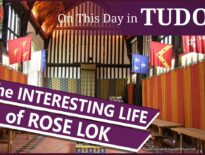On this day in Tudor history, 30th December 1552, in the reign of King Edward VI, Spanish humanist scholar, translator, author and Protestant apologist, Francisco de Enzinas died at Strasbourg from the plague. He was buried there the next day. Humanist Francisco had changed his name to Francis Dryander after leaving Spain to study at Louvain.
Dryander fit a lot into his thirty-four years of life. He escaped from prison and was an outlaw, he translated the Bible, he taught Greek in England, he was supported by Archbishop Cranmer and the Duchess of Suffolk, and published several works.
Find out more about the accomplished Francis Dryander in today's talk.
Also on this day in history, 30th December 1568, in the reign of Queen Elizabeth I, Roger Ascham, scholar and royal tutor, died. He was laid to rest in the St Stephen’s chapel of St Sepulchre without Newgate, London. Ascham served as tutor to Princess Elizabeth, the future Elizabeth I, and is also responsible for the idea that Lady Jane Grey had abusive parents.
Find out more about Roger Ascham, his life and career, in last year’s video:
Also on this day in history:
- 1494 – Death of John Russell, Bishop of Lincoln, Keeper of the Privy Seal, Lord Chancellor under Edward IV and Richard III, and Chancellor of Oxford University. He died at his episcopal manor in Nettleham, Lincolnshire, and was buried in Lincoln Cathedral.
- 1546 – Henry VIII signed his last will and testament, authorising the changes which he had ordered to be made by William Paget on 26th December.
- 1553 – Death of Roger Barlow, Vice-Admiral of the Pembrokeshire coast and brother of William Barlow, Bishop of Chichester, at Slebech.
- 1594 – Death of Sir Thomas Scott, member of Parliament and deputy lieutenant of Kent. He was buried at Brabourne Church in Kent, but moved to the chapel of Scot's Hall, the family home in Smeeth, after the Civil War. Scott was also a Justice of the Peace, Commissioner of Piracy, Commissioner of Coastal Defence, Commissioner of Grain and Colonel-General of his county's forces during the Spanish Armada. He was also a keen horse breeder.
- 1600 – Death of Michael Heneage, member of Parliament, devout Protestant, archivist and antiquary, at Hoxton in Essex. He and his brother Thomas served as Joint Keepers of the Records in the Tower of London from 1576, and he also helped Robert Hare, Compiler of Cambridge University's records. Heneage delivered two papers, “of the Antiquity of Arms in England” and “of Sterling Money”, while he was a member of the Society of Antiquaries, and he also compiled “Collections out of various Charters, &c., relating to the Noble Families in England”.
Transcript:
On this day in Tudor history, 30th December 1552, in the reign of King Edward VI, Spanish humanist scholar, translator, author and Protestant apologist, Francisco de Enzinas (humanist name Francis Dryander), died at Strasbourg from the plague. He was buried there the next day.
Dryander had been a member of the household of Katherine Brandon, Duchess of Suffolk, for a time, possibly teaching her son Charles, and Archbishop Cranmer paid him as a Greek Reader. While he was at Cambridge, in the late 1540s, Enzinas translated various ancient texts into Spanish before travelling to the Continent in 1549 to set up a publishing house in Strasbourg. There, he published at least nine classical and Biblical translations.
Let me tell you a bit more about this European scholar…
• Dryander was born Francisco de Enzinas, probably in November 1518 in San Gil, in Burgos, Spain. He was the son of wealthy wool merchant, Juan de Enzinas. It is thought that his mother was Ana de Sandoval, but his father married again after her death, marrying Beatriz de Santa Cruz from an important Burgos family in 1528.
• By 1539, due to his family’s links and business, Francisco was in the Low Countries, where he studied at Louvain’s Collegium Trilingue, which was known as a centre of humanist learning. His brother, Diego, also studied there. While in Louvain, Francisco changed his name to Francis Dryander and began studying the classics and the Bible, as well as being influenced by the works of Erasmus and Luther.
• While in Louvain, he became friends with Garbrand Harkes, a bookseller from Oxford, Edmund Crispin from Oriel College, Oxford, and Jan Laski, the Polish reformer.
• In 1541, Dryander travelled to Paris to visit his relative, theologian Pedro de Lerma, dean of theology at the Sorbonne, then he made his way to Wittenberg, where he began at the university, choosing to study there because of his admiration for Reformer Philip Melancthon. While he was there, he translated the New Testament into Spanish, the first modern translation of it into Spanish, publishing it in 1543. Dryander sought an audience with Emperor Charles V to present him with a copy of his New Testament and to get his protection as there were plenty of people who opposed the translation of the Bible. Unfortunately, this plan didn’t work, and the emperor’s confessor, Dominican Pedro de Soto, ordered Dryander’s arrest and ordered for copies of the work to be confiscated. Accused of heresy, Dryander was imprisoned at Brussels, but managed to escape in February 1545, but was then an outlaw.
• Back in Wittenberg, Dryander wrote an account of his imprisonment and escape. Then, in Basel, in 1546, he published his history of the death of Juan Diaz, the Spanish Protestant who had been murdered. He studied at the university at Basel temporarily, but didn’t enjoy his studies.
• In 1547, Dryander received news that his brother, Diego, had been burnt as a heretic in Rome. This led to him leaving Basel for Strasbourg, feeling he was safer there.
• In 1548, in Strasbourg, Dryander married exile Marguerite d’Elter, who was originally from Guelders. Then, in July 1548, after reformer Martin Bucer had advised him leaving the Continent, Dryander and his wife travelled to England, where Protestant Edward VI was on the throne. They resided with Archbishop Thomas Cranmer in Lambeth for a time. Historian Jonathan L Nelson believes that Dryander gave the archbishop a copy of Spain's ancient Mozarabic liturgy because the baptism blessing in the 1549 Book of Common Prayer seems to use it.
• Cranmer and Catherine Willoughby, Duchess of Suffolk, whose sons attended Cambridge, helped him move to Cambridge to teach Greek there, although he wasn’t an official professor at the university. The duchess was keen on the idea of him teaching her son, Charles. Dryander’s first child, Margarita, was born while the couple were living in Cambridge.
• During his time at the university, Dryander worked on translating works by Plutarch, Livy and Lucian into Spanish. His translation of Plutarch’s “Lives” was published under the name of Juan Castro de Salinas, which appears to link to the Duchess of Suffolk, whose mother was Maria de Salinas.
• In 1549, Dryander left his wife and daughter in the care of Martin Bucer while he travelled to Basel with his works, as he was unhappy with English printing. He didn’t return, and in 1550, his wife and child joined him in Strasbourg, where Dryander set up his own publishing house. Over the next two years, he published at least nine translations of the Old Testament and classical works.
• In around 1551, Marguerite gave birth to another daughter, Beatriz, but plague hit Strasbourg in 1552 and Dryander died on 30th December 1552, being buried the next day. He was just 34 years of age. Sadly, Marguerite only outlived him a few months, dying on 1st February 1553, also of the plague. Their daughters became wards of the city of Strasbourg, although their paternal step-grandmother Beatriz fought the authorities for custody.
• Dryander’s memoirs were published in French a few years after his death, and in 1995, his correspondence with the likes of reformers Martin Bucer, Philip Melancthon, John Calvin and Heinrich Bullinger, was published.



Leave a Reply